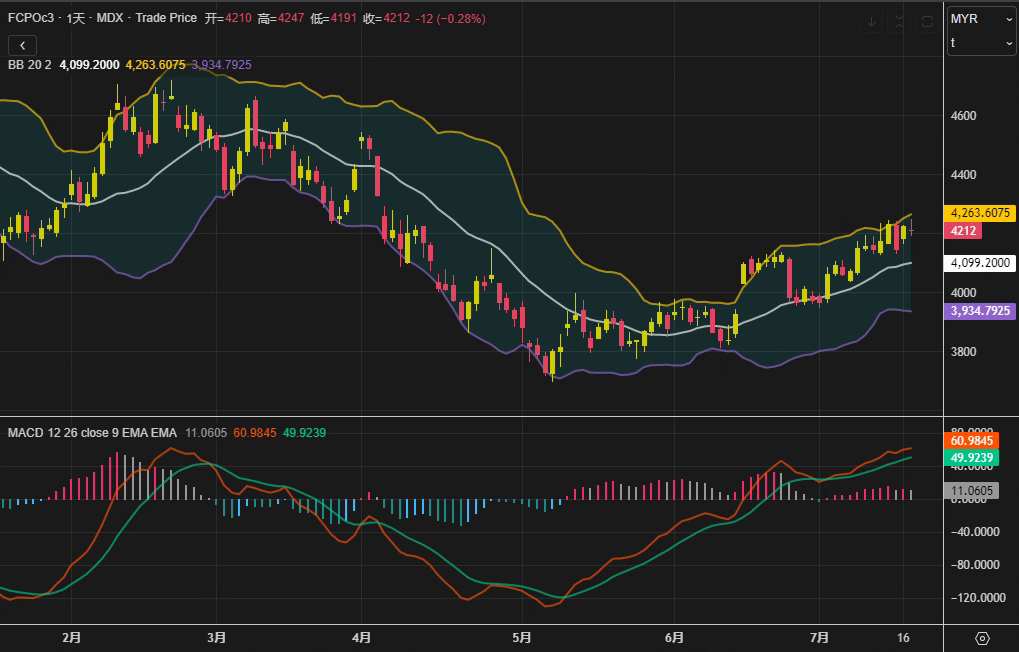Behind the “high opening and low closing” of palm oil: export data “exploded”, traders urgently adjusted their positions
2025-07-17 18:52:28

Weak export data triggers profit-taking
Data from independent inspection agency AmSpec Agri Malaysia showed that Malaysia's palm oil exports from July 1 to 15 fell 5.3% from the same period in June, while another agency, Intertek Testing Services, recorded a 6.2% drop. Kuala Lumpur traders pointed out: "Despite the firm performance of Dalian palm oil and Chicago soybean oil, the decline in exports still triggered long positions to be closed." This data weakened the market's previous optimistic expectations for a recovery in demand after Ramadan, especially the slowdown in purchases in India and the Middle East.
At the policy level, Malaysia raised the reference price of crude palm oil in August to an export tax rate of 9% (8.5% in July), which may further dampen buyers' enthusiasm. However, the ringgit depreciated by 0.17% against the US dollar on the same day, partially offsetting the pressure on prices caused by the tariff increase.
Biodiesel demand and external market support
Indonesia's developments provide bottom support for the market. As of July 16, the country's biodiesel consumption has reached 7.42 million kiloliters, completing 47.5% of the 2025 allocation target. The Indonesian Plantation Fund Agency predicts that the scale of palm oil tax this year will reach 30 trillion rupiah (about 1.84 billion US dollars), which is enough to cover the demand for biodiesel subsidies. Under this policy background, the role of Indonesia's domestic consumption in digesting global palm oil stocks cannot be ignored.
The performance of the external oil and fat market was differentiated: the main soybean oil contract of the Chicago Board of Trade (CBOT) rose by 0.49%, the soybean oil futures of the Dalian Commodity Exchange rose by 0.5%, and the continuous palm oil contract rose by 0.87%. An analyst from a Singaporean institution believed that: "The widening price gap between soybean and palm oil may stimulate some demand to shift to palm oil, but we need to be vigilant about the potential suppression of soybean oil prices by the bumper soybean harvest in Brazil."
Institutional view: Short-term adjustments and long-term contradictions coexist
Well-known agency Fitch Solutions pointed out in its latest report that Southeast Asia's palm oil production has entered a seasonal growth cycle, but the recovery of yields is subject to the delayed impact of last year's El Nino, and "the pace of inventory rebuilding in the third quarter may be lower than the five-year average." The agency also emphasized that if Indonesia's B40 biodiesel test is implemented within the year, it will completely change the supply and demand balance sheet.
In terms of technical analysis, the trading director of a futures company in Kuala Lumpur reminded: "There is obvious resistance in the FCPOC3 contract near 4250 ringgit. If it fails to break through, it may fall to the 4100-4150 range." However, he also added that the current position data showed that the proportion of commercial hedging positions had increased, indicating that the industry was cautiously optimistic about forward prices.

- Risk Warning and Disclaimer
- The market involves risk, and trading may not be suitable for all investors. This article is for reference only and does not constitute personal investment advice, nor does it take into account certain users’ specific investment objectives, financial situation, or other needs. Any investment decisions made based on this information are at your own risk.










